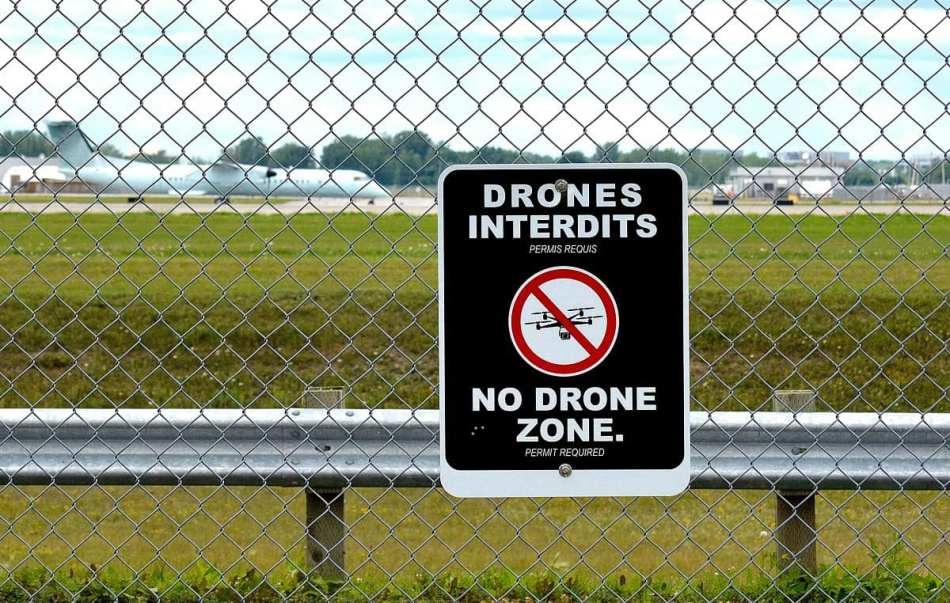May 17 2019
Embry-Riddle Aeronautical University has signed a licensing agreement with Drone Defense Systems LLC of Daytona Beach, Florida to commercialize an innovative technology that detects and commandeers rogue drones, and then guides them to land safely.
 An international airport prominently features its drone policy outside of the runway. (Image credit: Getty Images)
An international airport prominently features its drone policy outside of the runway. (Image credit: Getty Images)
Devised by Embry-Riddle faculty member Dr Houbing Song, the new technology proposes a safe and cost-effective method to neutralize unauthorized drones—without the necessity to force them to crash-land or shoot them down—even in civilian environments like airports and large outdoor entertainment arenas.
As part of the recently signed licensing agreement, exclusive rights have been granted to Drone Defense Systems LLC to commercialize the novel technology, informed Dr Stephanie A. Miller, who is an executive director of technology transfer for Embry-Riddle’s Research Park. Moreover, Sotirios George Kaminis, the company’s Founder and CEO will work with Embry-Riddle and Dr Song to further develop the concept, construct a prototype, and pursue relevant products, reported Dr Miller.
How does the technology work?
The system proposed by Dr Song exploits a network of wireless acoustic sensors to detect a flying drone. In order to differentiate drones from birds, Song and his PhD students—Jian Wang and Yongxin Liu—developed a special computer-based “brain” known as a neural network that is constantly learning and thus becoming more intelligent. Once a drone is confirmed by the system, the acoustic sensors, which operate in combination with beacon receivers, convey the information to a control center.
Whenever a drone is on an unauthorized flight, advanced pattern-recognition methods will be used by Dr Song’s system to decode the video-streaming channel of the drone and thus interrupt the broadcast with a cautioning message.
For each drone, the acoustic pattern might be a little different, but we can tell them apart, just as anyone can distinguish between a songbird and the noise of a crow.
Yongxin Liu, PhD Student, Embry-Riddle Aeronautical University
The communication channel of the drone can also be hijacked by the system to activate its pre-determined return flight, or alternatively, trick the drone into exiting the area, stated Dr Song, who is an assistant professor in the Electrical, Computer, Software, and Systems Engineering program and also the director of the Security and Optimization for Networked Globe Laboratory (SONG Lab).
It disrupts communication between the pilot and the drone. It detects the drone, finds out what language the drone speaks, activates an emulation system that mimics the drone’s language, and snatches control away from the pilot.
Sotirios George Kaminis, Founder and CEO, Drone Defense Systems LLC
A Growing Problem
The novel technology addresses a growing public safety and security risk.
Reports of drone sightings from pilots, citizens and law enforcement have increased significantly over the past few years. The U.S. Federal Aviation Administration currently receives more than 100 such reports each month. The goal of our technology is to counter unauthorized drones effectively, while ensuring low collateral damage and low cost per engagement.
Dr Houbing Song, Assistant Professor, Department of Electrical, Computer, Software, and Systems Engineering Program, Embry-Riddle Aeronautical University
Current approaches for combating unauthorized drones range from deploying birds of prey to shooting nets, bullets, or channel-jamming electromagnetic noise at rogue drones. While there are corporate and military drone-jamming technologies, the cost of those systems renders them inaccessible for private venues or smaller airports, stated Kaminis.
By contrast, the technology developed by Dr Song can possibly be developed at a lower cost, added Kaminis. The systems would work in a wide range of environments and also over long distances. “Our solution is friendly,” stated Song. “Rather than destroying the drone, we guide it to a safe landing place.”
This method provides significant benefits, stated Kaminis, whose company is already marketing another similar counter-drone technology.
My existing product is intrusive—it’s considered a weapon because it jams drones and makes them fall out of the sky. The Embry-Riddle technology is non-intrusive, so it is ideal for civilian applications and easy to export as it doesn’t fall under ITAR (International Traffic in Arms Regulations).
Sotirios George Kaminis, Founder and CEO, Drone Defense Systems LLC
In the early 1980s, Kaminis and his wife Rita shifted from Greece to Daytona Beach when the former attended Embry-Riddle Aeronautical University. Angelos, one of the Kaminis’ two sons, is currently a student at the university and is also serving as a manager of Student Union operations and events.
Kaminis is hopeful about the prospects of Dr Song’s invention. “When people work together and put their heads together, great things can happen,” Kaminis stated. “We’re going to make history for Embry-Riddle.”
Embry-Riddle Aeronautical University, Dr Song, and his PhD students Wang and Liu have filed a U.S. patent application. Dr Song credited Dr Susan Allen, associate dean for research in Embry-Riddle’s College of Engineering, while introducing her to Kaminis.